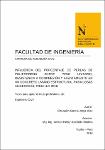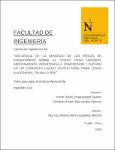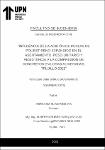Mostrar el registro sencillo del ítem
Influencia del porcentaje de perlas de poliestireno sobre peso unitario, resistencia a compresión y asentamiento en un concreto liviano estructural para losas aligeradas, Trujillo 2018
| dc.contributor.advisor | Azañedo Medina, Wiston Henry | |
| dc.contributor.author | Chuquilin Garcia, Jorge Alex | |
| dc.date.accessioned | 2019-02-05T17:44:01Z | |
| dc.date.available | 2019-02-05T17:44:01Z | |
| dc.date.issued | 2019-01-17 | |
| dc.identifier.citation | Chuquilin, J. A. (2018). Influencia del porcentaje de perlas de poliestireno sobre peso unitario, resistencia a compresión y asentamiento en un concreto liviano estructural para losas aligeradas, Trujillo 2018 [Tesis de licenciatura, Universidad Privada del Norte]. Repositorio de la Universidad Privada del Norte. Recuperado de https://hdl.handle.net/11537/14821 | es_PE |
| dc.identifier.uri | https://hdl.handle.net/11537/14821 | |
| dc.description.abstract | El siguiente trabajo de investigación se realizó en la ciudad de Trujillo, en el laboratorio de concreto de la Universidad Privada del Norte, y tuvo como objetivo general, determinar cómo influye las perlas de poliestireno sobre el peso unitario, resistencia a la compresión y asentamiento en un concreto liviano estructural para losas aligeradas. Inicialmente se procedió a caracterizar los agregados, tanto el fino como el grueso, bajo las normas NTP. Seguido se procedió a elaborar el diseño de mezcla para un concreto con una resistencia de 210 kg/𝑐𝑚2 a partir del método ACI 211. Para este trabajo se buscó obtener un concreto liviano estructural que pueda ser aplicado a losas aligeradas, para lo cual se sustituyó el agregado fino por porcentajes de 10%, 20%, 30%, 40% y 50% de perlas de poliestireno, en función del volumen. El asentamiento y el peso unitario se evaluaron al concreto en estado fresco, bajo las normas NTP 339.035 y 339.046, y para la resistencia a la compresión, el concreto en estado endurecido, para lo cual, se hicieron probetas en moldes de 30 cm de altura y un diámetro de 15 cm. Para el concreto convencional, se obtuvo un asentamiento de 80 mm, un peso unitario de 2430 kg/𝑚3 y una resistencia a compresión de 283 kg/𝑐𝑚2 . Por otro lado, el concreto con porcentajes de poliestireno, presentó reducciones en el peso unitario promedio y la resistencia a la compresión promedio, con respecto al concreto convencional, pero un aumento en el asentamiento promedio del 37.35% entre el concreto convencional y el concreto con perlas de poliestireno. (50%). El reemplazo óptimo se da en el 40% de perlas de poliestireno, donde se obtiene un asentamiento de 100 mm, un peso unitario de 2160 kg/𝑚3 y una resistencia a compresión de 242 kg/𝑐𝑚2 . Se dice que es el óptimo debido que el asentamiento cumple para la construcción de losas aligeradas, ya que según Rivera (2013), el asentamiento permitido para la construcción de losas está en un rango de 50 mm y 100 mm, el peso unitario es menor al promedio del concreto convencional, por lo cual se considera ligero, ya que según Lituma y Zhunio (2015), nos indica que se considera un concreto ligero cuando su peso unitario es menor al del concreto convencional, el cual está en un rango de 2200 kg/𝑚3 y 2400 kg/𝑚3 ; y la resistencia a compresión es estructural, esto según la norma E.060 Concreto Armado (2009), donde indica que la resistencia mínima de un concreto estructural es 210 kg/𝑐𝑚2. | es_PE |
| dc.description.abstract | The following research work was carried out in the city of Trujillo, in the concrete laboratory of the Universidad Privada del Norte, and its general objective was to determine how polystyrene beads influence the unit weight, resistance to compression and settlement in a lightweight structural concrete for lightened slabs. Initially we proceeded to characterize the aggregates, both the thin and the thick, under the NTP standards. Next, we proceeded to develop the mix design for a concrete with a resistance of 210 kg/𝑐𝑚2 from the ACI 211 method. For this work we sought to obtain a lightweight structural concrete that can be applied to lightweight slabs, for which the fine aggregate was substituted by percentages of 10%, 20%, 30%, 40% and 50% of polystyrene beads, depending on of the volume. The settlement and the unit weight were evaluated to the fresh concrete, under the norms NTP 339.035 and 339.046, and for the resistance to the compression, the concrete in hardened state, for which, test tubes were made in molds of 30 cm of height and a diameter of 15 cm. For conventional concrete, a settlement of 80 mm, a unit weight of 2430 kg/𝑚3 and a compressive strength of 283 kg/𝑐𝑚2 was obtained. On the other hand, the concrete with percentages of polystyrene, presented reductions in the average unit weight and the average compression resistance, with respect to conventional concrete, but an increase in the average settlement of 37.35% between conventional concrete and concrete with polystyrene beads. (fifty%). The optimal replacement is given in 40% of polystyrene beads, where a settlement of 100 mm, a unit weight of 2160 kg/𝑚3 and a compressive strength of 242 kg/𝑐𝑚2 is obtained. It is said to be the optimum because the settlement complies for the construction of lightened slabs, since according to Rivera (2013), the allowed settlement for the construction of slabs is in a range of 50 mm and 100 mm, the unit weight is less to the average of conventional concrete, which is why it is considered light, since according to Lituma and Zhunio (2015), it indicates that it is considered a lightweight concrete when its unit weight is less than that of conventional concrete, which is in a range of 2200 kg/𝑚3 and 2400 kg/𝑚3; and the compressive strength is structural, this according to the E.060 Armed Concrete Standard (2009), where it indicates that the minimum strength of a structural concrete is 210 kg/𝑐𝑚2. | es_PE |
| dc.description.uri | Tesis | es_PE |
| dc.format | application/pdf | es_PE |
| dc.format | application/msword | es_PE |
| dc.language.iso | spa | es_PE |
| dc.publisher | Universidad Privada del Norte | es_PE |
| dc.rights | info:eu-repo/semantics/openAccess | es_PE |
| dc.source | Universidad Privada del Norte | es_PE |
| dc.source | Repositorio Institucional - UPN | es_PE |
| dc.subject | Concreto | es_PE |
| dc.subject | Estructuras | es_PE |
| dc.subject | Resistencia de materiales | es_PE |
| dc.title | Influencia del porcentaje de perlas de poliestireno sobre peso unitario, resistencia a compresión y asentamiento en un concreto liviano estructural para losas aligeradas, Trujillo 2018 | es_PE |
| dc.type | info:eu-repo/semantics/bachelorThesis | es_PE |
| thesis.degree.grantor | Universidad Privada del Norte. Facultad de Ingeniería | es_PE |
| thesis.degree.level | Título Profesional | es_PE |
| thesis.degree.discipline | Ingeniería Civil | es_PE |
| thesis.degree.name | Ingeniero Civil | es_PE |
| dc.publisher.country | PE | es_PE |
| dc.subject.ocde | https://purl.org/pe-repo/ocde/ford#2.01.01 | es_PE |
| thesis.degree.program | Pregrado | es_PE |
| dc.description.sede | Trujillo San Isidro | es_PE |
| renati.advisor.dni | 41526075 | |
| renati.advisor.orcid | https://orcid.org/0000-0003-1737-3500 | es_PE |
| renati.author.dni | 71221469 | |
| renati.discipline | 732016 | es_PE |
| renati.juror | Ramírez Mercado, Roger | |
| renati.juror | Villar Quiroz, Josualdo | |
| renati.juror | Vasquez Díaz, Alberto | |
| renati.level | https://purl.org/pe-repo/renati/level#tituloProfesional | es_PE |
| renati.type | http://purl.org/pe-repo/renati/type#tesis | es_PE |
Ficheros en el ítem
Este ítem aparece en la(s) siguiente(s) colección(ones)
-
Tesis [1436]







